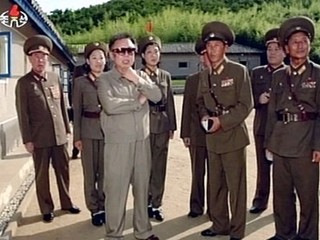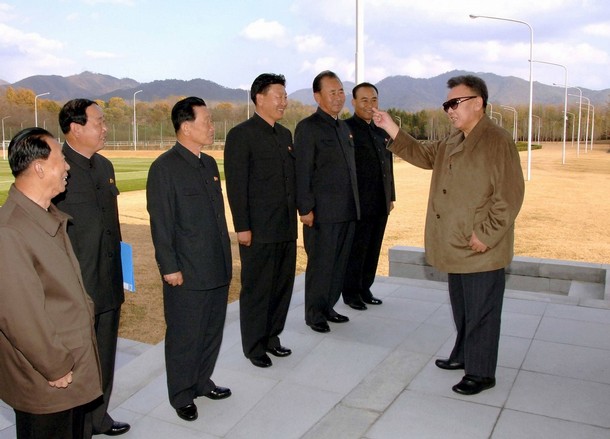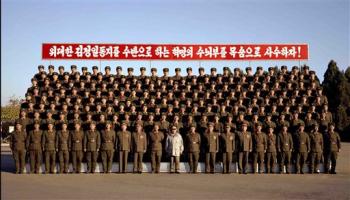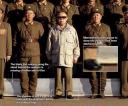UPDATE 2: Hany Farid, professor of computer science at Dartmouth College and author of a June Scientific American article on detecting fake images, argues the photos could be legit in a recent article in Scientific American:
“The BBC pointed to, I think, three or four things that they thought were indicative of tampering. And in the full-resolution image you can see that they’re completely wrong.” (Farid reviewed the photograph at the request of the Associated Press.)
One alleged manipulation was between the shadow cast by Kim’s legs and the shadows cast by the soldiers flanking him—a discrepancy that Farid says can be resolved by accounting for a curvature of the background surface. “If you look closely at the back baseboard, which all the men are standing at, it’s actually curved,” he says. “So what [the news agencies] are assuming is that that backboard is straight. If that backboard is straight and there’s only one light source, they’re right, it’s hard to explain that difference in the shadow.”
But assuming a curvature, the men would naturally cast different shadows. Farid calculates that only a few inches of background difference would suffice: “the sun is at such a grazing angle, so small differences make huge variations in the length of the shadow.”
The BBC also pointed to “apparently mismatched pixels” around Kim’s legs. But Farid says that the BBC “did this thing that is very dangerous, which is they zoom and they say, ‘Oh look, it’s a splice line around his feet,'” indicating that the leader may have been edited in. The problem with such an approach, he says, “is that’s all JPEG compression artifacts, and if you actually do the same thing to anyone else’s feet you see exactly the same artifacts.” Image compression uses a sort of digital shorthand to reduce the size of the files, throwing out certain nuances in favor of approximations that can be somewhat choppy. “What that means is there’s a quite a bit of color artifacts when you zoom in like that. So you completely expect those types of thing.”
“Quantitatively, I ran a number of forensics tools, and there’s no cloning, there’s no color-filtering artifacts, the lighting is completely consistent, you can explain the shadows,” Farid says. “The image was edited, as all images are, because they all get cropped and contrast-enhanced, but other than that, there was just no signs of tampering anywhere.”
UPDATE 1: In the comments, Neil points to the KFA explanation for the vanishing black line—that it is a “white board” which serves as a place marker where KJI is supposed to stand. See photos here, here, and here. This claim, however, does not address the “shadow” and “pixel” evidence.
According to the Straits Times (Singapore):
Seoul’s main spy agency, the National Intelligence Service (NIS), said yesterday that it believed the latest North Korean photo was real.
‘The possibility of Mr Kim’s photo being forged seems very low,’ said an NIS spokesman, refusing to elaborate.
The South’s unification ministry spokesman Kim Ho Nyoun also said he had no evidence to suggest that the photo had been forged.
ORIGINAL POST: In an attempt to quell speculation that Kim Jong il is suffering from poor health, the North Korean government has released a series of photographs showing the Dear Leader is fit and in control.
Unfortunately, in true North Korean fashion, the level of competence on display has merely increased speculation that “something is rotten in the Kingdom of Denmark.”
Case1:

Image 1: October 11, KCNA television broadcast of Kim Jong il inspecting a military unit. Although this effort was likely aimed at quieting rumors among a domestic audience, internationally it met skepticism because Kim is wearing his “summer” clothes and the foliage in the background is too green for the season. As a result many concluded that this footage was shot before August 2008.
Case 2:

Image 2: November 2, KCNA announces Kim Jong il talks to officials at a stadium where he watched a soccer match between military teams Mankyongbong and Jebi. KCNA did not state expressly the date the picture was taken.
Although the background and clothing seem to indicate the correct season, I was skeptical of this photo because of previous research I had done on Kim’s penchant for football—he doesn’t seem to have one. If this story was true, it would be the second match Kim has attended since 1996—the first also being after he allegedly suffered health problems.
The authors of several web pages, however, paid closer attention to the photograph itself and noticed a strange lack of shadows, indicating that the photo was doctored.
Case 3:

Image 3: November 5, Korea News Service in Tokyo shows Kim Jong Il posing with officers and soldiers with the (north) Korean People’s Army Unit 2200.
The BBC, however, reports that this photo is also doctored:

Quoting from the article:
The image, released on Wednesday, appeared to show Mr Kim in good health while inspecting two military units.
But an analysis by the UK’s Times newspaper highlighted incongruities around the leader’s legs, and the BBC found what look like mismatched pixels.
In the photo, the shadow cast by Mr Kim’s calves runs in a different direction to the shadow cast by the soldiers on either side of him, the Times pointed out. In addition, a black line running along the stand on which the soldiers are positioned mysteriously vanishes on either side of Mr Kim – suggesting his picture may have been superimposed onto the image.
Such a suspicion was reinforced when a BBC designer examined a close-up, and discovered apparently mismatched pixels to the right of Mr Kim’s legs.
[Accordng to Aiden Foster-Carter,] North Korean authorities will now face renewed pressure to prove Mr Kim is alive and not incapacitated.
“If they want to stop speculation, they have to produce him – as long as they don’t, we will still wonder.”
Read more in the following articles:
‘Fake photo’ revives Kim rumours
BBC
11/7/2008
Kim Jong Il: digital trickery or an amazing recovery from a stroke?
Times of London
Richard Lloyd Parry
11/7/2008
Did North Korea fake photos of Kim Jong-il?
Scientific American
11/10/2008
John Matson




